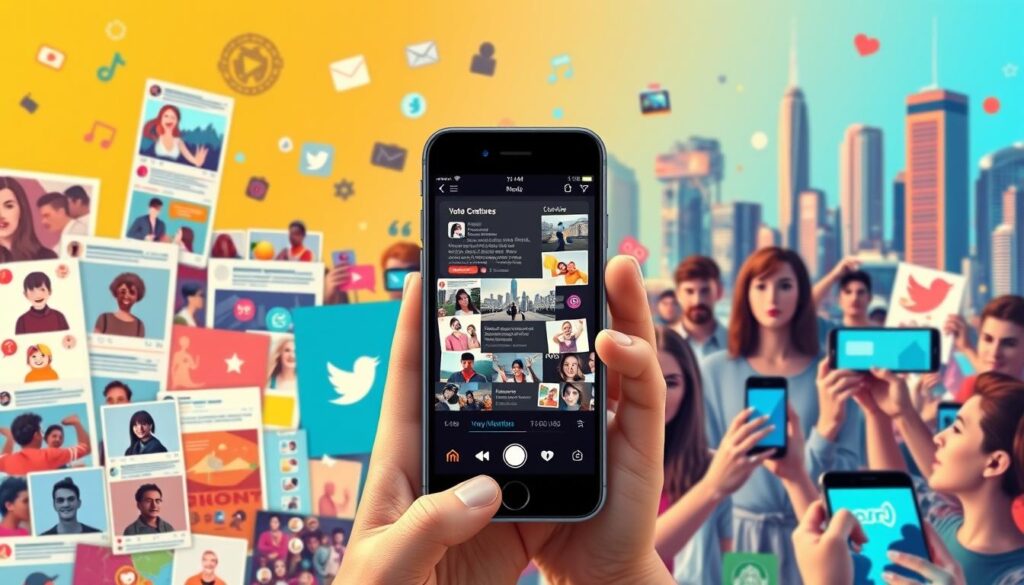In today’s digital world, user-generated content (UGC) is key for managing your brand’s reputation. It lets consumers share their own stories and experiences. This helps brands build real connections with their audience.
This approach boosts trust and encourages people to engage more with your brand. By using UGC in your marketing, you can make your brand stand out online.
Table of Contents
Key Takeaways
- User-generated content builds authenticity and trust with your audience.
- Engagement levels can rise significantly through community-driven strategies.
- Authentic content fosters brand loyalty and strengthens customer relationships.
- Leveraging UGC can enhance your overall online reputation.
- Effective digital branding incorporates user-generated content into marketing plans.
- Utilising UGC enables brands to connect emotionally with consumers.
What is User-Generated Content?
User-generated content (UGC) is any content like text, images, videos, and testimonials made by people, not brands. It’s like modern-day word-of-mouth. It greatly influences what people buy, often more than ads do. Brands that use UGC become more trustworthy and gain customer loyalty.
UGC is everywhere, from social media to YouTube. People share their product experiences online. This gives real views on products, helping others decide. Using UGC in marketing boosts engagement and shows a brand’s true story. It builds a loyal customer base that shares the brand’s values.
The Importance of User-Generated Content in Today’s Market
In today’s market, user-generated content (UGC) is key because people want real stuff. Traditional marketing isn’t working as well, so UGC is vital. It helps increase online engagement and affects buying decisions for 79% of people.
UGC builds a community around brands. This makes customers feel part of something, boosting loyalty. Using real content on social media or in campaigns strengthens your brand’s connection with its audience. For example, Branded Hashtag Challenges on TikTok can go viral, attracting young people.
Understanding User-Generated Content and Its Impact on Branding
User-generated content (UGC) is key in today’s brand management. It uses real user experiences in marketing to boost credibility. UGC shows real interactions, making brands seem more open and trustworthy.
Building Trust Through Authenticity
Brands that use UGC show they are genuine. Real testimonials make customers believe the brand values their opinions. This builds trust and strengthens customer relationships.
By sharing user stories, brands create a sense of community. This makes customers more loyal and likely to recommend the brand.
Benefits of Integrating User-Generated Content into Your Strategy
Adding user-generated content (UGC) to your marketing plan has many perks. One big plus is saving money. UGC is free because people share their own stories and photos. This helps your brand grow without spending a lot.
Cost-Effective Marketing
UGC makes marketing cheaper. You don’t need to pay for expensive photoshoots or ads. Instead, you use real content from customers. This approach is affordable and effective, helping your brand grow.
Enhanced Engagement Rates
UGC gets more people talking than ads do. When people share their experiences, their friends are more likely to join in. This creates a strong community around your brand. For more on how UGC helps brands, check out this link.
Different Types of User-Generated Content
User-generated content is very valuable for brands. It helps them build a good reputation through real interactions. Knowing the different types of content can help you use them well in your social media plans.
Social Media Posts
Social media posts are a great source of user-generated content. People often share photos, stories, and opinions about products on sites like Instagram, Facebook, and Twitter. These posts show real-life experiences, drawing in new customers with honest reviews and personal stories.
Product Reviews and Testimonials
Written reviews and testimonials are very powerful. They give insights into how well products work. Good testimonials can make people trust your brand more than ads.
Videos and Unboxing Experiences
Videos are a fun way to share content, like unboxing experiences. They let customers see how products are used. This visual approach can really grab your audience’s attention, encouraging them to learn more about your brand.
How to Encourage User-Generated Content
Getting people to create content for your brand can really boost your visibility. It helps you connect better with your audience. Start by making engaging campaigns and challenges that spark creativity.
These efforts not only get people talking about your brand but also build a lively community. Here, users feel important and valued.
Creating Compelling Campaigns and Challenges
Make campaigns that speak to your audience, with a clear call to action. Challenges can be themed or event-based, pushing users to show off their creativity. Think about a photo contest or asking for personal stories about your products.
Such campaigns lead to genuine content that truly represents your brand’s message.
Utilising Hashtags for Engagement
Using catchy hashtags can make your content more visible. It helps create a community among those who participate. Make sure your hashtags are easy to remember and use.
When you engage with this content on social media, it encourages more interaction. This boosts your efforts in integrating social media into your strategy.
Curating and Showcasing User-Generated Content
Choosing the right user-generated content (UGC) is key to good content curation. It should match your brand’s story. By sharing UGC, you create a lively community that connects with your customers. Real stories from users build trust in your brand.
UGC can be images, videos, or testimonials. These stories make your brand more relatable and boost engagement. Valuing customer contributions strengthens community and loyalty.
Using best practices in content curation can help your brand grow. Always get permission to use UGC. Giving credit to creators is good for your reputation and encourages more sharing.
Creating a plan for UGC helps tell a compelling brand story. This emotional connection with your audience is powerful. For tips, check out user-generated content resources.
| Type of UGC | Examples | Benefits |
|---|---|---|
| Images | Customer photos using products | Visual appeal, authenticity |
| Videos | Product reviews, tutorials | Engagement, storytelling |
| Testimonials | Written reviews from customers | Trust-building, social proof |
| Podcasts | Customer interviews and stories | Deep connection, relatability |
By using smart content curation and UGC, you build strong bonds with your audience. This approach not only showcases your customers but also shows your brand’s true self. Today’s shoppers value authenticity.
Utilising User-Generated Content on Various Platforms
User-generated content is a treasure for brands wanting to shine on different platforms. It boosts credibility and gets people more involved. Good tactics include using social media and email marketing wisely.
Social Media Integration
Adding UGC to your social media makes your content more relatable. People trust what others say more than ads. Using customer photos, reviews, or feedback in your posts can increase engagement and build a community.
Studies show UGC can really up engagement rates. It’s key to use social media to connect with people who might buy your products.
Email Marketing Strategies
Adding UGC to your emails makes your messages more powerful. Sharing customer testimonials and photos can make your brand’s story more compelling. This builds trust and can get more people to click on your emails.
Highlighting UGC in emails creates a genuine connection with your audience. It makes them feel important. For more on using UGC in emails and social media, check out this resource.
Measuring the Success of User-Generated Content Campaigns
It’s key to know how well your user-generated content (UGC) campaigns are doing. By looking at certain metrics, you can see if your plans are working. This part will talk about Key Performance Indicators (KPIs) and how to check what people really think, both important for judging your UGC efforts.
Key Performance Indicators (KPIs)
Using KPIs lets you measure how UGC affects your brand. Important KPIs include:
- Engagement rates
- Conversion metrics
- Reach and impressions
- Brand awareness levels
By keeping an eye on these KPIs, you can see how well your UGC is doing. This helps you make your strategy better. Checking these regularly helps you know where to improve.
Customer Sentiment Analysis
Looking at what people think about your brand and content is very useful. Tools that check sentiment scores can show feelings that people might not say out loud. Important things to look at are:
- Customer feedback trends
- Social media mentions
- User interactions and conversations
Using these insights, you can make your campaigns better. This helps your brand connect more with your audience. It makes sure your marketing stays on track and interesting.
Turning Negative Feedback into Positive Brand Moments
Managing negative feedback is key to improving customer experience. When faced with criticism, quick and professional responses can turn a negative into a positive. Showing you care by addressing concerns openly builds trust with current and future customers.
By sharing how you’ve fixed issues, you show your commitment to making customers happy. This not only strengthens loyalty but also improves your public image. Highlighting successful resolutions can attract more customers who value honesty.
Handling negative feedback well helps build stronger relationships with your audience. Each solved complaint boosts trust, leading to more loyal customers. This approach makes your brand more resilient and respected in the market.
Legal and Ethical Considerations in User-Generated Content
Using user-generated content (UGC) comes with legal and ethical rules. It’s key to follow these to keep your brand’s good name and avoid legal trouble. Always get clear permission from users before sharing their work. This step stops copyright issues that could harm your brand.
Acquiring Permissions and Giving Credit
Getting permission for UGC is not just about the law; it builds trust with your audience. Giving credit to the creators boosts trust and encourages more sharing. Make sure your campaign follows your brand’s values and ethical standards.
Clear rules for credit and permissions are essential. Fair deals with creators are also important. Being open about sponsorships shows you’re transparent and ethical. For more on handling these issues, check out this resource on UGC ethics.
Key Case Studies of Successful User-Generated Content Campaigns
User-generated content has changed how brands work in many fields. It has made a big difference in how people interact with brands and how loyal they are. Many examples show how using this method can help brands get better and reach more people.
GoPro is a great example of using UGC well. They have a YouTube channel full of videos made by their customers. These videos show exciting moments, making GoPro look good and building a community around it.
Lululemon focuses on building a community by using branded hashtags. This lets people share their fitness stories, making everyone feel part of something bigger. It shows how UGC can make a brand more popular and get people excited about it.
LaCroix uses social media to talk to its fans. They start hashtag challenges, letting people show off their creativity. This creates lots of content that people love, making the brand more known and trusted.
These examples show how big of a difference UGC can make for brands. When brands involve their community and are true to themselves, they can really connect with people. Using UGC not only makes a brand look better but also gets people to share their good experiences.
Conclusion
Embracing user-generated content is key for brands wanting to boost their reputation and engage with their community. By using UGC in your marketing, you can build real connections with your customers. This leads to trust and loyalty, which are vital in today’s market.
As the digital world changes fast, using UGC is vital for staying relevant and socially responsible. It lets you connect with your audience in a meaningful way. This strengthens their bond with your brand. So, using user-generated content is not just a choice; it’s a must for growing and keeping customers over time.
FAQ
What is user-generated content (UGC)?
User-generated content (UGC) is any content made and shared by people, not brands. It includes text, images, videos, and reviews. These are genuine endorsements that act like modern word-of-mouth for brands.
How does UGC impact brand reputation?
UGC boosts a brand’s reputation by building trust with possible customers. Real experiences shared through UGC are powerful endorsements. They make people more likely to buy from a brand.
Why is UGC important in today’s digital marketing landscape?
UGC is key today because people want real content. As they doubt traditional ads, UGC offers relatable, trustworthy content. It greatly influences what they buy.
How can brands incorporate UGC into their marketing strategies?
Brands can use UGC by asking customers to share their experiences. They can do this through social media campaigns, contests, and challenges. Using hashtags helps make content more visible and engaging.
What types of content can be considered user-generated?
UGC includes social media posts, product reviews, and photos and videos from customers. It also includes unboxing experiences and any content showing real interactions with the brand.
How can brands measure the success of their UGC campaigns?
Success can be tracked with Key Performance Indicators (KPIs) like engagement rates and conversion metrics. Analyzing brand sentiment also helps. This data shows how well UGC works and where it can be better.
What should brands do with negative UGC?
Brands should handle negative UGC professionally and quickly. They should address concerns openly. This shows they care about improvement and can turn negatives into positives for customer loyalty.
What legal and ethical considerations should brands keep in mind with UGC?
Brands need to get clear permission to share UGC and always credit the creators. Having clear UGC guidelines ensures it fits with the brand’s values and ethics.
Can you provide examples of successful UGC campaigns?
GoPro’s YouTube channel is a great example, featuring content from customers. Lululemon and LaCroix also use branded hashtags to encourage community contributions. This boosts authenticity and reach.









